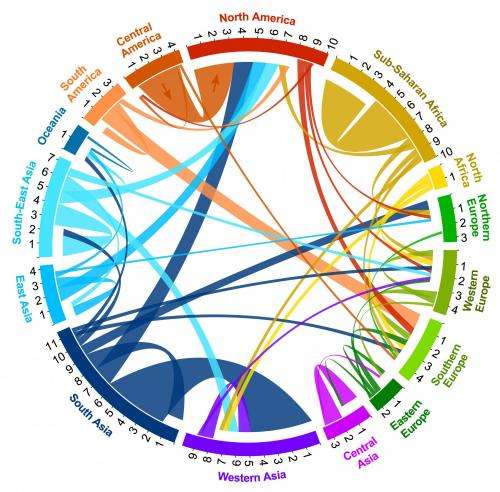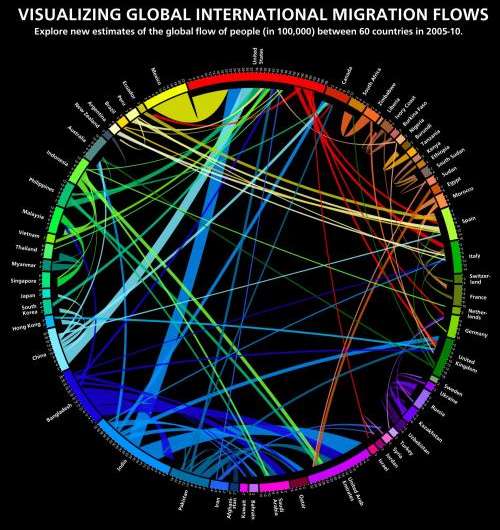March 28, 2014 report
Research duo quantify global human migration numbers

(Phys.org) —A pair of demographic researchers at the Vienna Institute of Demography has quantified for the first time global human migration numbers. In their paper published in the journal Science, Guy Abel and Nikola Sander describe how they were able to gather migration numbers for 196 countries and some of the trends they discovered in doing so.
The modern era has provided the means to migrate to far off lands like no other time in history, jet travel along with higher standards of living has meant people could pick up and move to another country if they so desired. Of course, there are also limiting factors, such as laws regulating immigration and diminished desire to leave one's homeland if things are going well. At the same time, with massive computer infrastructures and the World Wide Web, it would seem that some entity would exist that monitors global human migration—the United Nations for example. But that is not the case, as Abel and Sander discovered, leading them to conduct a study of their own. Their work was greatly aided by an initiative by the United Nations last year to merge migration numbers reported by different countries into a single format.
Using data provided by the UN and other organizations and governments, Abel and Sander managed to gather statistics on 196 countries across the globe covering four, five-year time periods between 1990 to 2010. After putting all the data together and analyzing it, the two found that global migration has held steady at approximately 0.6 percent over the two decade period—a figure that has come as a surprise to those who have believed that it has been rising steadily.

Abel and Sander also report on notable migration patterns—their data shows, for example, that the greatest number of migrants involves people moving from places like India and Pakistan to places like oil-rich countries in the Middle East. It also shows that migration in African is generally intra-continental, and that people from Europe tend to migrate to a diverse number of countries. Also of note, the large numbers of people migrating to the United States, with the largest block coming from Mexico, though there are also significant numbers coming from China and India as well.
In their report, Abel and Sander also note that though migration due to refugees seeking relief from war or other disasters makes the news, it generally accounts for a very small percentage of permanent migration numbers.
More information: — "The Global Flow of People" interactive data visualization: www.global-migration.info/
— Paper: Quantifying Global International Migration Flows, Science 28 March 2014: Vol. 343 no. 6178 pp. 1520-1522. DOI: 10.1126/science.1248676
ABSTRACT
Widely available data on the number of people living outside of their country of birth do not adequately capture contemporary intensities and patterns of global migration flows. We present data on bilateral flows between 196 countries from 1990 through 2010 that provide a comprehensive view of international migration flows. Our data suggest a stable intensity of global 5-year migration flows at ~0.6% of world population since 1995. In addition, the results aid the interpretation of trends and patterns of migration flows to and from individual countries by placing them in a regional or global context. We estimate the largest movements to occur between South and West Asia, from Latin to North America, and within Africa.
Journal information: Science
© 2014 Phys.org


















